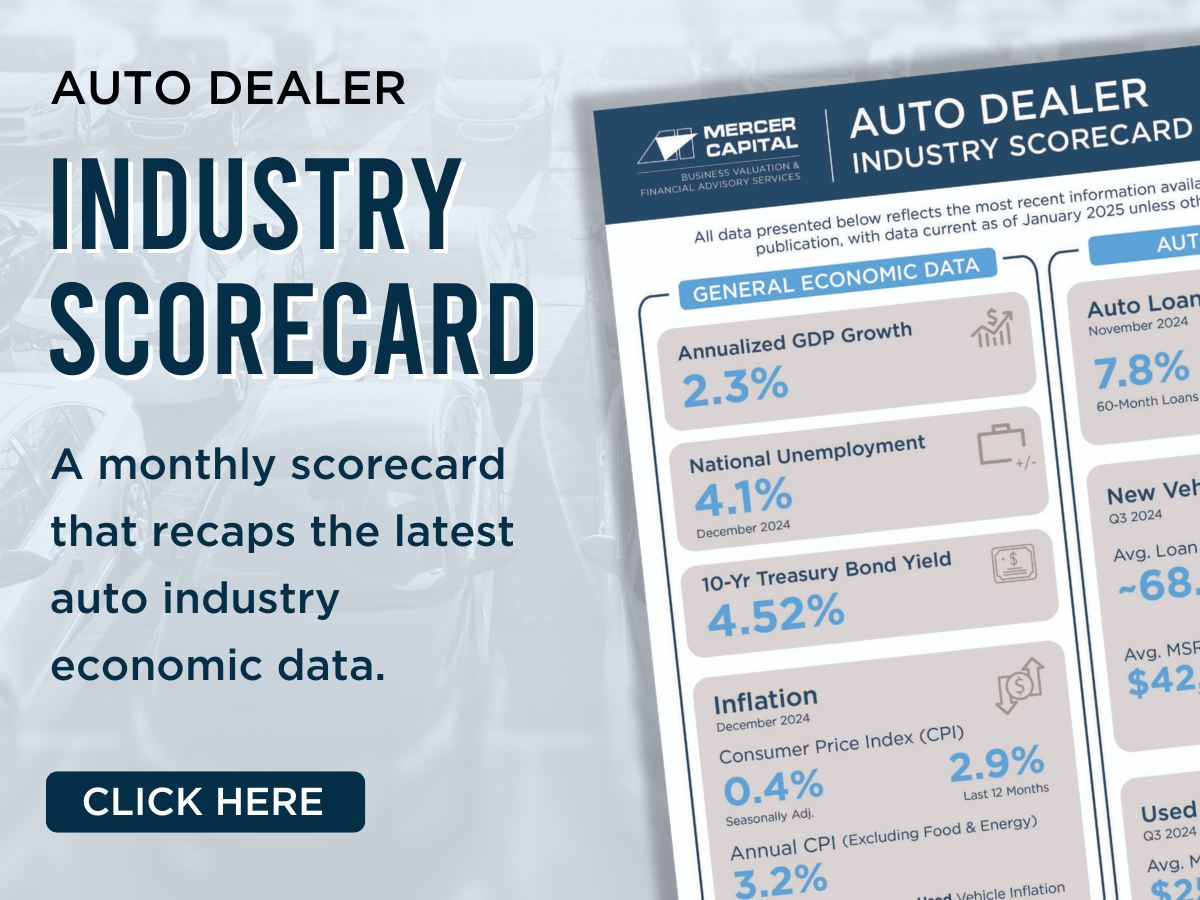Overview of Auto Finance in 2025
Origination, Delinquency, and Portfolio Trends
Auto dealers that sell new vehicles nationwide rely on their Finance and Insurance (“F&I”) departments as an important source of earnings. While top-line revenue from the F&I department is typically a small portion of a new car dealership’s total revenue mix, these departments have much more favorable margins than their counterparts in the selling division. For used dealers without subsidiary captive finance operations, third-party lenders play a larger role in the financing process, and the economics tend to differ from those of their new vehicle-selling counterparts.
Last June, we released a 2024 Overview of Auto Finance, which included a layout of the auto finance industry. In this week’s post, we review current themes in auto finance and lay out new developments and changes since last year. Experian releases a “State of the Automotive Finance Market” webinar every quarter. The information in the most recently released webinar outlines origination, portfolio balances, and delinquency trends observed in the first quarter of 2025. A summary of these trends follows.
How and What Type of Vehicles Are Being Purchased?
During Q1 2025, more new vehicle buyers financed purchases or leases than in the last two Q1s. Financing was employed in 80.5% of new vehicle purchases in Q1 2025, up from 80.4% in Q1 2024 and 79.5% in Q1 2023. Furthermore, new vehicles now make up a larger share of total auto loans in the market. New vehicles accounted for 43.3% of all financing activity in Q1 2025, up from 40.9% in Q1 2024 and 37.8% in Q1 2023.
Leasing has gained traction, rising to 24.7% of new vehicle transactions
This trend toward financing newer inventory is also reflected in the declining average age of vehicles that were financed during the quarter. During Q1 2025, the average age of a vehicle financed was 3.83 years, which compares to 4.08 years in Q1 2024 and 4.24 years in Q1 2023. Additionally, leasing has gained traction, rising to 24.7% of new vehicle transactions, up from 23.7% during Q1 2024 and 19.2% during Q1 2023. We think that consumers are seeking lower monthly payments in response to high prices and interest rates by opting to lease instead of own new vehicles.
What Types of Lenders Are Financing These Purchases?
Total Financing
Captives have maintained their position as the largest source of total auto financing during Q1 2025, accounting for 29.8% of total vehicle financing. This continues the trend that began in early 2023 when captives overtook banks as the top auto lender. Banks now hold 26.6% of the total financing share, up from last year but still trailing captives. Credit unions remain the third-largest group, with a 20.6% market share. The shift in lender mix reflects banks’ continued caution in expanding their consumer auto lending portfolios, part of a broader retreat that began during the COVID-19 pandemic.
However, when focusing solely on auto loans (excluding leases), the ranking changes. Banks lead the total loan market with a 29.1% share, followed by credit unions with a 23.7% share and captives making up 21.1%. This distinction highlights the dominant role captives play in lease financing, as well as their increasingly strategic use of promotional rates to retain new vehicle buyers within their ecosystem. For dealers, lease programs offer more opportunities for interaction with consumers, which can lead to increased brand loyalty. Leasing can also help fixed operations, which are higher-margin profit centers than variable operations.
New Vehicle Financing
Captives remain the top lenders for new vehicle purchases, although their share has slightly declined. During Q1 2025, captives financed 57.1% of all new vehicle deals, down from 62.1% in the same quarter last year. Banks and credit unions accounted for 24.1% and 10.9% of new car financings, respectively. Despite the drop in market share, captives continue to dominate this segment thanks to their ability to offer lower interest rates and loyalty incentives that traditional lenders can’t match. These manufacturers’ in-house finance arms also benefit from vertical integration, enabling more efficient recovery and remarketing processes in the event of delinquencies.
Captives remain the top lenders for new vehicle purchases
Used Vehicle Financing
Used vehicle financing remains more fragmented, particularly between franchised and independent dealer channels. For franchised dealers, banks led the way in Q1 2025, accounting for 37.8% of total used vehicle loans, followed by credit unions at 31.6%. Captives continue to participate in the used market—especially through certified pre-owned (CPO) programs—but at significantly lower levels than new vehicle financing. For independent used vehicle dealers, the financing landscape shifts dramatically. Only 15.3% of financing came from banks, while BHPH lenders made up 34.3% of the total. Credit unions financed 21.5% of purchases at independents. This distribution reflects both the risk profile of independent dealer clientele and the limited presence of captives in that channel.
Consumer Credit Scores and Credit Quality
Credit quality across auto financing continues to improve. On a total financing basis, the average credit score for new vehicle buyers rose two points year-over-year to 756, while used vehicle buyers held steady at 684. The super prime segment expanded further in Q1 2025, reaching 33.0% of total financing (loans and leases).
For new vehicle loans, prime and super prime buyers made up 83% of the total, consistent with recent years and underscoring the strong credit profile of new car borrowers. In the used vehicle segment, prime and super prime buyers accounted for 77.6%, reflecting continued improvement and a significant shift away from subprime financing.
Interest Rates and Term Lengths
Financing trends remained relatively stable in Q1 2025, though affordability challenges persist. For new vehicles, the average amount financed rose to $41,720, up modestly from $40,610 in Q1 2024. Average loan terms for new vehicles ticked up to 68.6 months, matching Q1 2023 and slightly up from Q1 2024. Interest rates remained elevated at 6.7% annually. Monthly payments averaged $745 for new loans and $595 for new leases, with nearly 14.5% of all new vehicle payments (loan or lease) now exceeding $1,000 per month.
Financing trends remained relatively stable in Q1 2025
In the used vehicle segment, the average amount financed is slightly higher than in Q1 2024 but remains below Q1 2023 levels. Furthermore, monthly payments and loan terms remained largely flat at $521 per month and an average term of 67.2 months. The average interest rate held steady at 11.9%, consistent with the past two years. In contrast to new vehicle purchases, only 4% of total used loans exceed the $1,000 monthly threshold.
Delinquency Trends
Delinquency trends in Q1 2025 indicate a modest improvement at the early stage, but overall stress remains elevated compared to pre-pandemic norms. The 30-day delinquency rate improved year-over-year from 2.10% to 1.95%, bringing it back in line with pre-COVID levels. However, 60-day delinquencies held steady at 0.83%, remaining above the historical pre-pandemic range of 0.50% to 0.70%. By vehicle type, used vehicle delinquencies were higher at 1.48% compared to 0.78% for new vehicles. Similarly, performance diverged by dealer type, with franchised dealers reporting a delinquency rate of 1.24% while independent dealers saw a higher rate at 1.76%. These trends indicate a greater risk concentration in the used and independent segments, which aligns with expectations.
Conclusion
As more inventory returns to dealer lots and price normalization continues, especially for used vehicles, consumers remain cautious amid elevated interest rates and affordability challenges. In this environment, profitability is increasingly reliant on strong performance across all profit centers, particularly finance and insurance (F&I). With loan terms, rates, and monthly payments all staying historically high, the F&I department remains a critical lever for maintaining margins and closing deals. For dealers nationwide, this may be the time to view F&I not as a volatility risk, but as a strategic growth opportunity in an evolving landscape.
Mercer Capital provides business valuation and financial advisory services, and our auto team helps dealers, their partners, and family members understand the value of their business. Contact a member of the Mercer Capital auto dealership team today to learn more about the value of your dealership.
 Auto Dealer Valuation Insights
Auto Dealer Valuation Insights 








